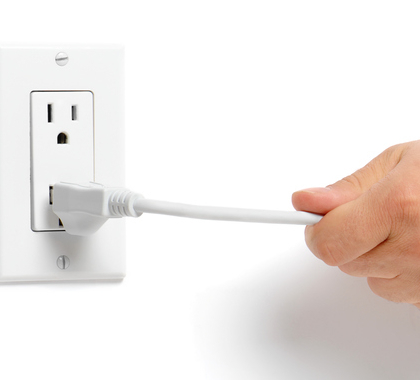The U.S. Food and Drug Administration (FDA) is proposing to ban a treatment that for 10 years has helped Paul Peterson’s autistic son, David, control his impulse to injure himself.
David, 45, resides under the care of doctors and treatment experts at the Judge Rotenberg Educational Center (JRC), a special-needs residential school in Canton, Massachusetts.
When David is tempted to engage in life-threatening behaviors, such as head-banging and shoving his hands down his throat, a two-second shock to his skin from an electronic stimulus device (ESD) dissuades him from harming himself.
FDA proposed a rule on April 25 to ban the use of ESDs to treat self-injurious behavior, having “determined that these devices present an unreasonable and substantial risk of illness or injury that cannot be corrected or eliminated by labeling,” the rule’s summary states.
FDA received 1,276 e-mailed and written comments about the rule during the comment period, which closed on May 25, according to the federal government website Regulations.gov. Unless FDA withdraws the rule, ESD treatment will be banned 30 days after the agency adds the final rule to the Federal Register, the proposed text states.
FDA Proposes Weaker Alternatives
Max Stern, an attorney for the JRC Parents Association, says FDA’s own research indicates the alternatives the agency has proposed are inadequate.
“The FDA convened a Neurological Devices panel in 2014 to provide a recommendation on whether to ban ESDs,” said Stern. “Comprised of experts in the field of behavioral treatment, the panel unanimously concluded that the other available treatments are not adequate to address the severe behavioral problems of a subpopulation of individuals.”
Glenda Crookes, executive director at JRC, says the ban puts at risk the well-being of people similar to David, who engage in self-injurious and aggressive behaviors not controllable by other means.
“The ban would deny them access to treatment with ESDs, the one treatment that has been successful in stopping that behavior,” Crookes said.
Alternative treatments FDA has suggested are less effective than ESD and potentially harmful, Crookes says. The antipsychotic medications Abilify and Risperdal are less effective for treating self-injuring autistic patients and can cause severe and permanent side effects, she says.
“Why the FDA is recommending these treatments over a proven, effective therapeutic approach that includes ESDs is unclear,” Crookes said.
Advocacy Groups’ Influence Cited
Peterson, a professor of government at Harvard University and director of Harvard’s Program on Education Policy and Governance, says FDA’s motion to prohibit ESD for autistic, self-injuring patients is motivated by ideology.
“While the device has been used effectively for many years with individuals like David … the FDA is trying to ban it at the behest of ideologically driven advocacy groups such as the Disability Law Center in Massachusetts, whose executive director calls the therapy ‘horrible torture,'” Peterson wrote in a Wall Street Journal op-ed on June 23 titled “Please Don’t Take Away My Autistic Son’s Treatment.”
“Amazingly, the FDA says similar therapy is allowable if it is used to deter cigarette smoking,” Peterson wrote.
Instead of consulting caregivers and parents at JRC and other such facilities, FDA is trusting individuals and organizations that use false information to influence policy at the state and federal levels, Stern says.
“Unfortunately, the FDA has placed credence on alleged ‘facts’ provided by uninformed sources without considering actual data on individuals receiving treatment with ESDs or doing their due diligence by, for example, accepting the Judge Rotenberg Center’s invitation to visit the facility and meet with residents and families of those whose treatment includes ESDs,” Stern said.
Verified by Scientific Studies
Stern says ESD treatment’s potential to help autistic people with self-injurious behaviors to participate in society is well-documented.
“It has been established in numerous scientific journal articles and in thousands of treatment cases that ESDs are safe, rapidly effective, prevent harm, and are critical for individuals with severe behavior disorders to avoid severe pain and physical harm, obtain an education, learn vocational skills, and integrate into the community,” Stern said.
FDA’s rule prioritizes inaccurate information over the actual experiences of patients, Stern says.
“It is a tremendous shame that the FDA has chosen thus far to listen to a group of uninformed advocates while overlooking the fact that a decision to ban ESDs would deprive highly vulnerable people of the one thing that has significantly improved their quality of life,” Stern said.
Parents Battle State Officials
Under a Massachusetts judicial decree, ESD treatments must be authorized on an individual basis through approval by a probate court judge. In June, Stern represented JRC parents opposing an attempt by state officials to overturn the decree. The case is currently under the court’s advisement.
“The FDA should have no role in determining whether anyone should receive treatment with ESDs,” Stern said. “The decision to treat an individual with ESDs should be left to the individual’s treating clinicians and undertaken only with the consent of the individual or his or her parents or guardians and with the approval of a court of competent jurisdiction.”
Crookes says FDA should respect the Massachusetts Supreme Court’s ruling.
“The Court authorizes [ESD] treatment when it is necessary to prevent the individual from engaging in aggression or self-injury that can be life-threatening,” said Crookes. “The Massachusetts Supreme Judicial Court ruled that interfering with this Court-approved treatment violates this consent decree. The FDA should not be allowed to interfere with court-approved treatments.”
Jenni White ([email protected]) writes from Oklahoma City, Oklahoma.
Image via Thinkstock





